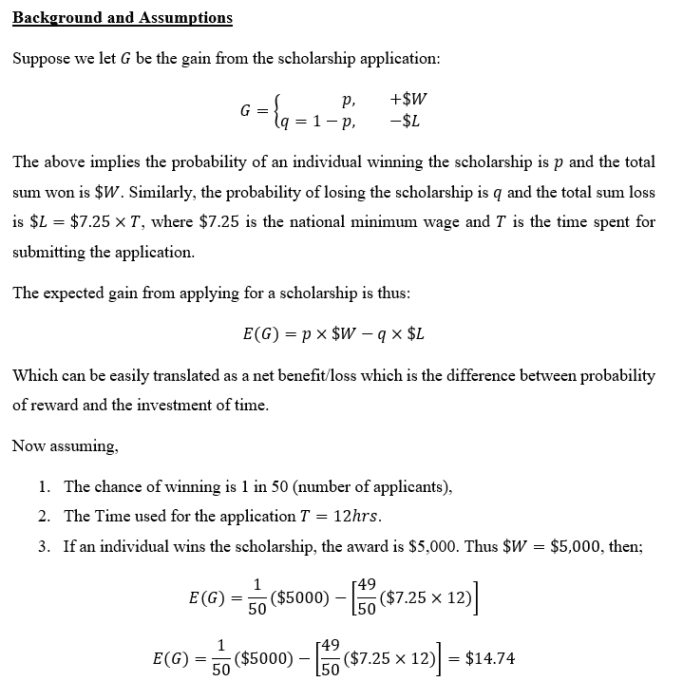Are scholarships really an effective and realistic way to lowering the cost of college? What I’m about to show you here will provide the ugly truth: they’re not worth your time.
I know what you’re thinking, “Wait??? So there aren’t billions of dollars in scholarships I can get?”
Sadly, no. In fact, the amount you’d likely be eligible for will be drastically less, probably highly competitive, and as we’ll illustrate, not worth the investment of time for potentially no reward.
Don’t worry though…I’ll cover some alternatives that are indeed worthwhile and time-effective ways to lower the cost of your education.
Scholarships: The answer to affordable education?
Yes, we all hear about the billions of dollars available in scholarships. We’ve been told it’s “free money”, and that it’s just waiting for us to simply reach up and take. Scholarships, scholarships, scholarships…that’s the answer to affordable education! If someone wants to lower the cost of their education, they simply need to begin applying and get as much of that free money as possible.
Sounds simple enough.
However, while the proposition may be superficially true, once you begin to peel back the onion a dramatically different picture begins to emerge. The vast options you thought were available to you in this large pile of money, are not really available to you after all.
In addition, when you add up the time spent (we’ll walk through the typical process and how it works), coupled with the likelihood of success, the math just doesn’t add up! As you’ll see from the calculations below, you’d probably be better off simply working a part-time job. This is true for traditional students coming straight out of high school, and even more true for busy adults looking to go back to school.
How are Scholarships Supposed to Work?
Many groups and organizations would like to help people get their education, and provide funding to help them do it. It’s a noble cause, and a wonderful deed to help people and society as a whole. I applaud their intent. These groups can vary: they could be non-profits, corporations, wealthy individuals, foundations, etc. The scholarships they fund all fall into the same basic structure though when it comes to the process. They all have essentially the same components:
- The amount to be awarded (e.g. $500, $5,000, etc)
- How often it will be awarded (annually or quarterly are the most common)
- A determined set of criteria that applicants must satisfy (more below)
- An application process with instructions for people to apply and potentially be chosen
Lets explore.
What does the application process typically entail?
This usually involves a lengthy questionnaire, open essay questions, and in most cases, an actual essay. There could be other requirements, and some interweave newer social media aspects as well (such as a video of yourself answering some of the questions, etc.). Once you properly submit the application according to their instructions and deadlines, the scholarship has a team of people who review the applications and choose a winner to receive the award (usually announced a few months after you submit).
Why do they make you submit so much information, you ask? They’re trying to get to know you better.
The individuals who are responsible for choosing the ultimate award winner need to gather as much information as possible about all of these strangers applying. It’s not easy to learn about someone genuinely, make a good determination, and keep the application process light and easy. I understand the issues they face. They may receive hundreds of applicants for a scholarship…how do you make the choice of who wins the award?
As a result though, the scholarship process is unfortunately cumbersome and lengthy. They require a lot of information in the application to help them make the determination. For the applicants, it makes it an involved process with a lot of writing and critical thought. You not only need to sit down and spend a lot of time writing these essays or essay questions, you really need to put a considerable amount of thought into your answers so you can differentiate yourself from the fierce competition.
More about those criteria…
The group that is offering the scholarship usually has a certain belief or mission for the type of person they would like to help. In addition to general application questions above, they may specify additional requirements or a particular slant for their respective scholarship. For example, a religious organization may limit the pool of applicants to those who share their same religion (if not mandatory, it could be preferred). Alternatively, a foundation dedicated to green sustainability may ask for an essay on how your degree and goals will better help the environment once you graduate. It’s not always this cut and dry, but that gives you a good idea.
These criteria are designed to limit the pool of applicants. The groups want to help people, but they normally overlay certain criteria so they direct their funds to the ideal candidate to match their objectives as well.
What most people don’t realize is that many scholarships get so highly specific in their criteria for applicants, that they preclude the vast majority of students from applying. When you begin to take these considerations into account, the available cache of options quickly disappears.
Which Scholarships Are Available?
Let me walk you through a few examples of how specific the criteria are for so many of these “available” scholarships, to show you how quickly your options get narrowed down.
One way to help determine which scholarships you could be eligible for is to eliminate the ones that you certainly don’t fit the criteria for. The simple process of elimination. There are tens of thousands of scholarships (if not more), and many websites where you can sift through hundreds of pages of lists! If you don’t want to be 100 years old by the time you finish applying, you definitely shouldn’t read the requirements for each one. It’s far more efficient to remove options categorically that you have no chance of getting.
Let’s dive in. In doing this practical exercise, I’ll show you what I mean.
Example 1: Athletic Based Scholarships
We’ll start with a first category: Athletic-based scholarships. Meaning, you’re eligible if you’re part of an athletic team at a university.
Ask yourself this question: How many applicants who are capable of competing athletically at the college-level really exist? As you probably guessed, not many. It’s a small portion of all college students. It’s unlikely statistically that it applies to any of us normal folk. Plus, if you’re a working adult looking to go back to school, would athletics even be an option? Of course not.
So, this first example shows how we can start removing these so called options from the table. Athletic Scholarships…out.
Example 2: Location-Based Scholarships
Let’s keep going. Next, many scholarships are geographic in nature: in other words, they could apply to residents of a particular state. So, if you live in Utah, you could be eligible for a range of scholarships exclusive to your state, but you wouldn’t be able to get scholarships for students living in Michigan, or vice versa. As a process of deduction, we can thus remove 49 out of 50 of those available scholarships assuming you have residency in only one state. Due to your physical location, you would only be eligible for 1 out of 50 geo-based scholarships.
That’s another big chunk that were removed from the table as well!
One Last Example: University-Specific Scholarships
What about scholarships that are specific to a particular university? This type of criteria is actually quite prevalent…perhaps because the alumni are the ones who established the scholarship. For these scholarships, applicants would only be eligible if they’re enrolling at that specific university. With that same process of deduction we used above, let’s see how this too limits many of the available options. Out of roughly 8000 universities in the country (yep there are that many), we’ll assume you’re only applying to 10 schools. That would eliminate 7990 university-based scholarships, or 99.87%, from your available options.
Starting to Make Sense?
With just 3 criteria above, we’ve significantly whittled down the availability of scholarships and our options are beginning to get much smaller. We could keep going through all of the categories, but you get the point. So, based on the above, we can safely conclude that whatever seductive dollar figure is assigned to all of the scholarships available in existence, it doesn’t really matter since one person will only be eligible for a tiny sliver.
However, despite that, let’s keep indulging this great myth of scholarship availability, and assume you do fall in the right demographic to apply for a particular set of scholarships. Ultimately there will be options where you DO FIT the criteria. Plus, since we’ve lowered the amount of scholarship options, doesn’t that mean we’ve removed so much of the competition as well? Don’t the numbers now make sense in terms of risk/reward to invest all of this time into applying? Let’s find out.
Submitting Applications
Of the eventual options where you do meet their criteria, you’ll find most scholarships range anywhere from $500- $5000. Given that you only have so much time to commit to complete these lengthy applications, and that you’re competing with many other students, we have to estimate the probable risk/reward.
The reality is that no scholarship awards are guaranteed. You could spend an infinite amount of time with no certainty of success.
One must then answer the question, “What am I likely to receive for the investment of time I’ll spend to complete these applications”.
Only then, would you be able to make the determination if scholarships are a big time waster or not. Again, you could hypothetically spend an infinite amount of time applying, and never win a single penny.
The Math

Let’s assume that you are only 1 of 50 people who apply. Next, we have to put a value on your time. Let’s also assume your time is worth only the absolute bare minimum national minimum wage of $7.25 per hour. Finally, since a large scholarship like this will usually require a lengthy essay, we’ll assume you only spend 12 hours completing the entire application (Searching for the scholarship, preparing your response, writing, proofreading, etc.) By the way, I know people that waste an entire weekend on one application, so this is being very generous. You can check out the math at the end of the article…even with these assumptions I can provide you the summary:
What do we get? (drum roll…)
$14.74
Yep, that’s the expected probable return given all of the generous assumptions above. $14.74.
Is that worth your time? You decide.
Also, what if you value your time more than the minimum wage of $7.25/hr? We’re all working adults here. What happens if you assume your time is worth a modest $12/hr?
If you insert the numbers into the equations, you now net -$41.12. In other words, increasing the value of your time to a mere $12 an hour changes the probability to a net result that is now negative.
In Conclusion: Do Scholarships Make Sense?
At that risk/reward, it doesn’t make sense for a high school student making minimum wage, let alone a working adult with even a modest salary. It’s simple probability math. Play with the math as much as you’d like with different assumptions.
Can you get lucky and things are wildly successful in your favor? Of course. Some people also win the lottery or a new car at a Vegas slot machine. But, it doesn’t change the fact that the odds are against you. Your time is valuable, and as we’ve shown, would be better spent working a normal job with the certainty of payment rather than applying for scholarships.
In conclusion, you’ll need to ask yourself if going down the scholarship road is worth your time based on the likely reward.
Scholarship Alternatives
So, does this mean we’re destined to pay full-price tuition for our education? Definitely not.
Is there a better way? Is there an alternative to lowering the price of college without the mighty scholarship? Absolutely.
Although overshadowed by the over-prescribed scholarship, there are in fact a number of proven and time-effective strategies to lower the cost of one’s education so you don’t overpay. Let’s go through each.
Instant College Discounts
People don’t realize that there are ways to save towards universities through tuition discounts. No scholarship applications, no searching for options that match your criteria, etc. A tuition discount immediately lowers your total cost of education without having to write a single essay. They could be anywhere from 5% to 25% depending on the school, and could equate to a huge chunk of savings.
I’m a huge proponent of this avenue as a way to help people efficiently and effectively lower the cost of their education. Who wants to spend weeks or months searching and applying to scholarships when you can instantly take advantage of a discount?
But, how do you find these discounts and be eligible?
At my startup, OnlineDegree.com, we’ve gone out and organized many tuition discounts at universities across the country on behalf of our registered users…for free.
You read that correctly: free. It’s all part of our mission to make college affordable for everyone. Simply register in 60 seconds, and you’re able to utilize any of these discounts to trim up to $15,000 from the cost of your education when you enroll at the respective college. That’s like winning the $5000 scholarship above, along with 10 $500 scholarships. Instantly, confidently, and without the hassles of submitting scholarship applications.
CLEP Exams
Many people applying to college already possess a breadth of knowledge. For instance, a high school student with a love of English literature may have taken an AP (advanced placement) course in English her senior year. Another student with a love of history may have spent countless weekends reading about the revolutionary war and all of its battles. And of course, an adult student, who has already been in the workforce for a number of years, received on-the-job training and experience that is perhaps inline with what they may learn in a college course. CLEP was created to help people like this earn their degree efficiently and inexpensively.
Rather than taking certain courses at college, you can instead take a CLEP exam from a company called CollegeBoard to satisfy the requirement. Pass the exam, fulfill the course. There are over 33 different exams to choose from. For example, they have an exam on English Literature which will test your knowledge of British authors and literary works that you would normally learn in a college course. By passing the exam you avoid taking the course when you enroll at college.
I love this option since it’s definitive…as long as my university accepts CLEP, I know that I will be saving money after I invest the time in taking the exam. It’s not a leap of faith. Pretty cool.
But, keep in mind: in addition to the $87 fee per exam, you will probably want to pay for a prep course. CLEP Exams are challenging and cover a lot of material…so, you’ll probably need help studying. Many companies offer prep courses and they can cost you a few hundred dollars. It’s still a huge savings over college tuition though, and a great way to save as opposed to a scholarship!
Free Courses for Credit
Most people don’t realize they can take courses online that could earn credit towards their degree before they even enroll…
- Lowering the price of college,
- Preparing you to be successful, and
- Helping you potentially finish more quickly.
For example, I created OnlineDegree.com for that very purpose to help make college more affordable and accessible. You can take as many college-level courses as you’d like…online, from anywhere, at your own pace, for FREE. You can learn about criminal justice, psychology, computer programming, business and many more from excellent professors around the country. We’ve then worked out relationships where participating universities across the country can give you credit for the courses you’ve finished. Complete the courses, enroll at the university, save time and money.
Again, a definitive investment of your time! You know exactly how much you’ll save when you commit. Furthermore, taking courses for credit has the added benefit of getting you closer to your degree completion in addition to the savings. A double win.
Which College Savings Path Will You Take?
Now that you’re informed and have the options, you can chart the right path that makes sense for you! Regardless, the value of a college education is huge…take the right steps to get there affordably and quickly.
To your success!
*Cornell Photo Attribution
JVinocur, |Description=Taken in Wikipedia:Ithaca, NY, in July 2005. This sign marks the southern entrance to Wikipedia:Cornell University’s West Campus. CC BY-SA 3.0 license
*Notes/Math
Related Articles
-
How to Be Successful in College in 2022 – 7 Simple Tips to Succeed
-
How Do Scholarships Work? Read This First…Truth is Shocking
-
7 Best College Majors 2024: What Should I Major In?
-
How to Choose a College – 10 Things You Must Consider in 2024
-
Why Go to College? Top 13 Benefits for Adult Students in 2022
-
Top 5 Best Alternatives to Community College for 2024










